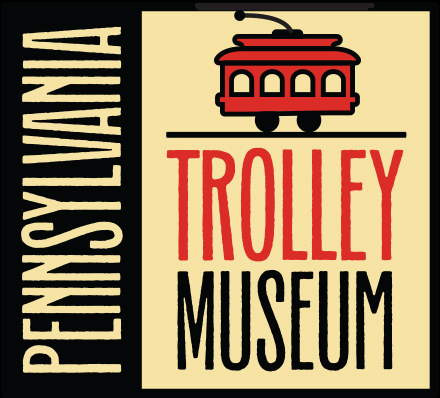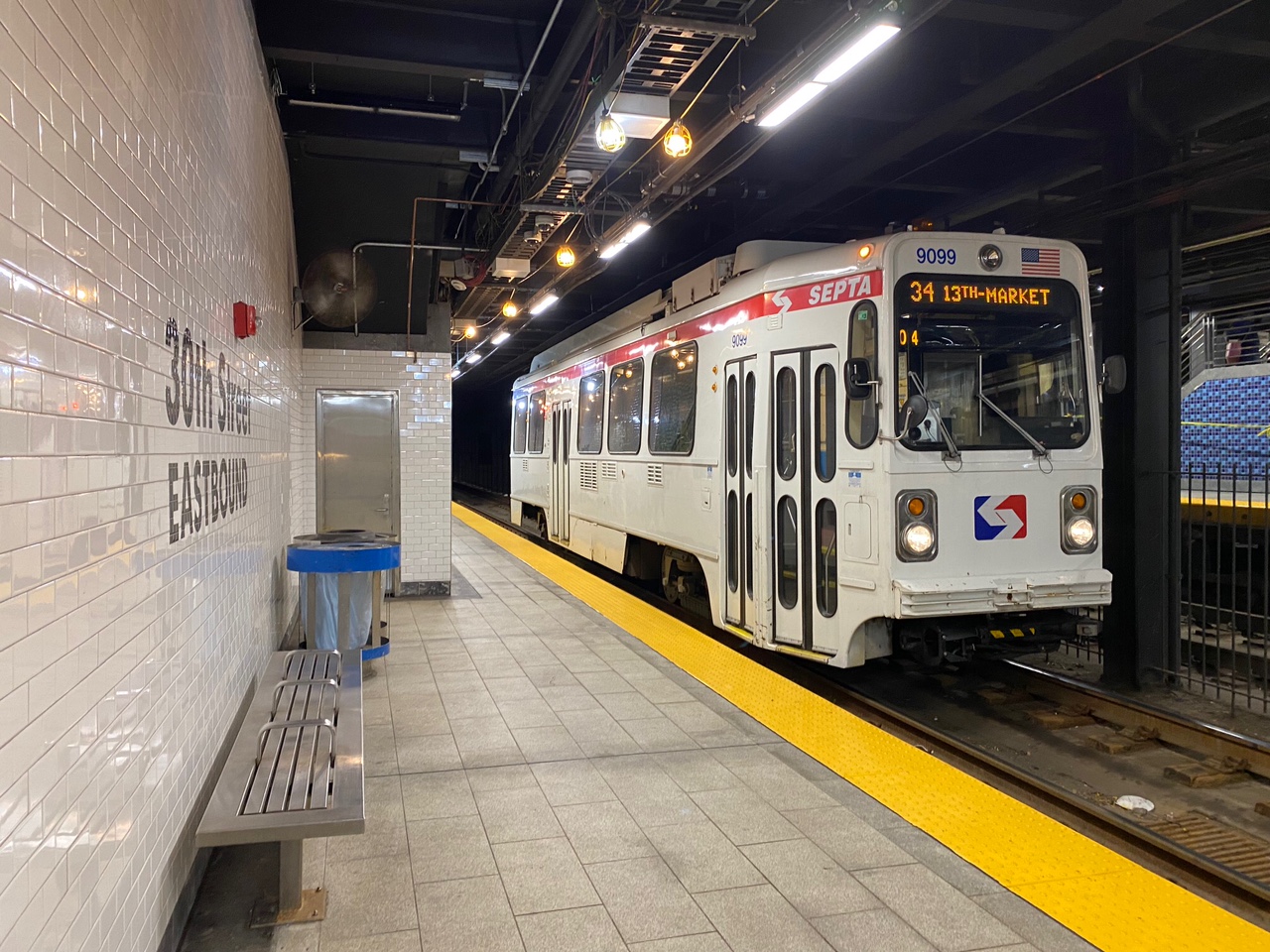Philadelphia Notes For
July – August – September 2022
By George Gula
Beginning on July 8 at 10 p.m. and continuing through July 25 at 5 a.m., the 10 the annual Transit Tunnel Blitz closed down the Center City Trolley Tunnel that runs from 13th Street to 40th Street so major work could be performed without interruption. “We run around the clock for a 16-day window,” said Dave Montvydas, Chief Engineer for SEPTA’s Engineering, Maintenance and Construction Division. “About 200 day-shift workers and about 150 workers on the night shift will swarm the tunnel”.
Work in the tunnel included the demolition and reconstruction of the entire eastbound platform at 22nd Street Station, including the replacement of the track bed. Worn rail was replaced at curves throughout the tunnel and four miles of new overhead wire was hung. In addition, the usual cleaning and flushing of pipes and drains was performed, switching equipment was repaired and tested and maintenance of the signal system was done. All stations underwent deep cleaning, repairs, graffiti removal and repainting, and workers repaired some spall, or crumbling concrete, on the tunnel walls and checked for any other signs of damage, according to Kate O’Connor, the Chief Engineer for Buildings and Bridges.
During the tunnel closure, trolley routes 10, 11, 13, 34 and 36 used the emergency surface trackage to 40th and Market Street. Here, riders transferred to the Market-Frankford Line for Center City and did the reverse from 13th Street in Center City. Tents were erected to shelter people transferring between the El and the trolleys. Late-night travelers were advised to take the Night Owl Bus Service that parallels the route of the Market-Frankford Subway.
About 18 months ago, SEPTA was outbid by Amazon for a 29-acre piece of land at 6901 Elmwood Avenue, once home to a General Electric plant, that was critical to the authority’s plans to modernize and upgrade its West Philadelphia trolley system. The land was needed so the authority could construct a new and enlarged car house where a new fleet of longer streetcars could be effectively maintained. Recently, the board authorized the purchase of 13.52 acres and a former steel fabricating plant at 5100 Grays Avenue, near Bartram’s Garden along the Route 36 line. “It just seemed to make everything fit,” said Dennis Stefanski, an engineer and senior project manager for trolley modernization. “It met a lot of our selection criteria.” The site is along an active car line and is located close to the 40th Street portal, making it easy to deploy cars. It is not in a flood plain, unlike many of the properties SEPTA was forced to look at farther south in the Eastwick neighborhood and it is in an industrial area, with few residences nearby. An existing building on the property is solid, with a vast interior that includes cranes. SEPTA’s plans are to salvage about 65% of that building to form the nucleus of the heavy maintenance facility. SEPTA officials are also negotiating with owners to buy two nearby scrap yards to be used for a rail yard and employee parking. The main property will be screened from a compact residential block to the south.
On August 3, Route 10 experienced delays of up to 10 minutes due to an automobile that was improperly parked too close to the track at 60th and Lansdowne. At the end of August, newly rebuilt PCC-III 2327 was spotted at Elmwood Depot getting its state inspection. Four more cars are at Woodland Depot in various states of rebuilding and 10 more cars are awaiting their turn to go through the shop. There is a rumor that the line may go back to rail in early 2023. If this is true, Route 15 will be operated with a mix of bus and streetcar.
On September 10, a 64-year-old man died after being shot multiple times shortly after 2:15 p.m. on the 19th and Market Streets subway-surface trolley platform. Trolley service continued in both directions throughout the evening rush-hour, but eastbound trolleys did not stop at 19th Street until the evening hours, after the investigation was completed.
After serving almost 20 years as the ice cream shop for Mt. Airy’s Trolley Car Diner, PCC car 2134 is now part of the Mural City Garden, a community-focused wine garden, located on Frankford Avenue in Kensington neighborhood. SEPTA will celebrate the 100th Anniversary of the Frankford Elevated in the Grand Hall located in the Frankford Transportation Center at Bridge Street. It will be open to the public. The authority has put out a call for photos of the elevated to use to document the elevated’s operations.
On Wednesday July 6, Route 101 Media rail service did not operate along State Street from 5 p.m. to 11 p.m. while the community’s “Dining Under the Stars” event occurred.
The Fox Chase Regional Rail Line was shut down from Fox Chase to Wayne Junction between July 5 and July 29, allowing wooden railroad ties to be replaced, track resurfaced, and concrete poles supporting overhead wires to be installed. Overgrown vegetation along the line was cleared at the same time. “The tie replacement and resurfacing will provide for a smoother, more reliable ride,” Montvydas said. “And there’ll be better drainage.” While the tracks were out, SEPTA crews did repair work to a bridge that is shared with freight railroad company CSX to any concrete abutments or steel that needed it. Waterproofing was installed before the tracks and pads were put back in. While this work was being performed, shuttle buses replaced all trains between Fox Chase and Wayne Junction stations. Passengers transferred there to other train service running into Center City.
The Southwest Connection, the $80 million project to upgrade switches, signals and interlockings along the Regional Rail track between 30th Street Station and University City, is now in its fifth year. This year’s work has been scheduled over several summer weekends: July 9-10; 16-17; and 23-24; Aug. 6-7, 13-14 and 20. The line will also be shut completely from Aug. 15 to 19. Officials indicated that supply chain issues had made it difficult to get the large huts needed to house computer and electronic equipment. This, and the difficulty in scheduling a crane, have forced 18 days of work to be spread out over about six weeks. Montvydas indicated that, “What we have out there now is at the end of its useful life, and it’s time to replace it.” To accommodate the train riders, SEPTA used a combination of shuttle buses and operated the Wilmington and Airport line trains on a reduced schedule. They arrived and departed from the lower level of 30th Street Station instead of the upper level. The authority posted signs and assigned employees both construction locations to assist confused passengers.
During June and July, when SEPTA was replacing worn out diversion track along South 40th Street, used by Route 10, its historic Belgian block was removed. Members of the Philadelphia Street Railway Historical Society had been attempting to save the Belgian block, without gaining much traction (a pun on words). Mark D. Sanders, President of the Society said “I’m still charging up the hill, but not expecting much. If it’s not to be, this will be just one of a long list of historical resources or artifacts lost over the years.” SEPTA said it is concerned about safety. Its engineers argued that the Belgian block loosened over time, making the tracks unstable and increasing the risk of a derailment, which happened a little more than 15 years ago in West Philadelphia. “The way we look at it, purely from the safety standpoint, the Belgian block in the track area is a technology from 100-plus years ago,” said David Montvydas, Chief Engineer of the authority’s engineering, construction, and maintenance division. “Technology improves. We’ve got a better, more resilient way of building our track now and that’s where we should be.” SEPTA crews have been removing the block and pouring concrete in its place to anchor the new rails.
Amy Lambert, preservation architect and president of the University City Historical Society said that the loss of the Belgian block was “tied, at the civic level, to a lack of a real embrace of our history and historical resources — in a city that’s an actual treasure trove of them.” Currently, the Philadelphia Historical Commission is staffed by only four people and has limited formal powers.
This summer, after years of efforts to save it, the clickety-clack of the flipping information board that once announced departures and arrivals at 30th Street Station and the wooden paving blocks along Camac Street disappeared. Belgian block was an innovation of the post-Civil War era. Companies were able to mass produce the granite stone, cutting it into uniform rectangles. It was far superior to cobblestone, more stable and with a smoother ride — important for the electric streetcar industry.
Lambert believes the Belgian blocks on South 40th Street were worth saving. “It’s a remnant of what made West Philly grow,” she said.
Although the former Route 40 trolley track, which was bussed in 1956, borders the West Philadelphia Streetcar Suburb Historic District, listed on the National Register of Historic Places, the designation does not protect any property or resource from demolition, though it brings tax breaks for historic rehabilitation projects, Lambert said. There is also a city-designated Historic Street Paving Thematic District, designed to preserve old pavements around the city like Belgian block and vitrified brick. However, SEPTA says it is exempt from the Historical Commission’s regulation when working in the track area because it owns the right-of-way, up to 18 inches on either side of the rails. The authority claims that, and the City’s Law Department agrees. The city solicitor made that ruling 15 years ago when the commission tried to stop SEPTA from removing granite-block paving from the track area on Chester Avenue. State historic preservation officials said they, too, had no jurisdiction in the matter. “We’ve got a small pile of them — like a mound — up at our Midvale facility just sitting there,” SEPTA’s Montvydas said. “We know that they’re historical and we don’t want to get rid of them. But we really don’t have a use for them either.”
Cover photo: Bill Monaghan


